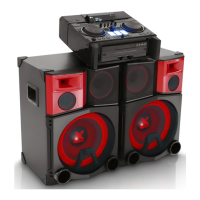
Do you have a question about the LG CM9950 and is the answer not in the manual?
| Type | Home audio mini system |
|---|---|
| Cassette deck | No |
| Product color | Black, Red |
| Number of decks | 1 deck(s) |
| Disc loading type | Tray |
| Optical disc player | Yes |
| Number of optical discs | 1 discs |
| Bass reflex | - |
| Speaker type | 4-way |
| RMS rated power | 4400 W |
| Tweeter diameter | 25.4 mm |
| Number of speakers | 2 |
| FM band range | 87.5 - 108 MHz |
| Supported radio bands | FM |
| Display type | LED |
| Backlight color | Various |
| Headphone outputs | 1 |
| USB 2.0 ports quantity | USB 2.0 ports have a data transmission speed of 480 Mbps, and are backwards compatible with USB 1.1 ports. You can connect all kinds of peripheral devices to them. |
| Microphone connectivity | 6.3 mm |
| Apple docking compatibility | Not supported |
| Playback modes | Random, Repeat, Repeat all |
| Disc types supported | CD, CD-R, CD-RW |
| Playback disc formats | CD audio |
| Audio formats supported | MP3, WMA |
| Equalizer modes | Bass, Classic, Jazz, Pop, Rock |
| Depth | 462 mm |
|---|---|
| Width | 495 mm |
| Height | 213 mm |
| Main unit weight | 810 g |
| Main unit dimensions (WxDxH) | 495 x 213 x 462 mm |
General safety precautions and warnings for the appliance.
Guidelines for safe usage and handling of the power cord.
Instructions for proper grounding to prevent electric shock.
Comprehensive list of safety guidelines for product operation.
Highlights of the product's special functionalities and capabilities.
List and identification of supplied accessories included with the product.
Specifications for compatible MP3/WMA audio file formats.
Information on USB devices supported by the unit.
Guidelines and limitations for connecting USB devices.
Explanation of the remote control's buttons and operation.
Instructions for installing batteries in the remote control.
Diagram and description of the unit's front panel controls.
Diagram and description of the unit's rear panel connections.
Instructions for attaching ferrite cores to speaker cables for interference reduction.
Guide on connecting speakers to the main unit correctly.
Details on connecting auxiliary devices via AUX IN.
Instructions for connecting devices using the AUX OUT port.
How to connect two units for synchronized playback.
Guide for playing music from portable players or external devices.
Steps for connecting USB devices to the unit.
How to connect the FM antenna for radio reception.
Fundamental procedures for CD and USB playback.
Automatic playback of audio CDs and USB devices.
How to navigate and select folders and MP3/WMA files.
Using various DJ sound effects like Flanger, Phaser, Chorus, Delay.
How to use the SCRATCH effect for sound manipulation.
Mixing CLUB or FOOTBALL sound effects.
Blending songs seamlessly for uninterrupted playback.
Changing the playback tempo for USB sources.
Mixing audio sounds from different sources.
Synchronizing audio file tempos from two USB sources.
Overview of Bluetooth wireless communication technology.
Supported Bluetooth profiles for the unit.
Steps to connect a Bluetooth device to the unit.
Instructions for downloading and installing the Music Flow Bluetooth app.
Connecting the unit to a Bluetooth device using the app.
How to tune into FM radio stations.
Tips for enhancing poor radio signal reception.
Steps for saving and removing radio station presets.
Selecting pre-set surround sound fields.
Adjusting Treble, Middle, and Bass levels.
Procedures for recording audio sources to a USB device.
How to choose bit rate and speed for USB recording.
Copying audio files between USB devices.
Sharing songs from a USB device via the Music Flow Bluetooth App.
Creating and playing playlists of favorite tracks.
Turning off the sound temporarily using the mute function.
Prevents sudden loud sounds upon unit startup.
Displaying MP3 file information (ID3 TAG) using INFO.
Demonstrating unit functions with sound.
Connecting and using a microphone with the unit.
Headphone monitoring and speaker lighting effects.
How to set the unit's clock time.
Synchronizing the clock using the Music Flow Bluetooth App.
Setting the unit to function as an alarm clock.
Setting the sleep timer and adjusting display brightness.
Unit automatically turns off to save electricity.
Unit turns on automatically based on input source.
Unit automatically switches functions based on input signals.
Common problems and solutions for unit operation.
Solutions for remote control malfunction.
Resolving problems with LG Sound Sync connectivity.
Technical details including power, dimensions, and inputs.
Detailed specifications for the front speakers.
Information on registered trademarks and software licenses.
Guidelines for disc care, unit cleaning, and shipping.